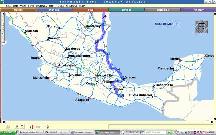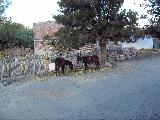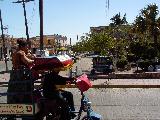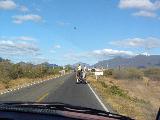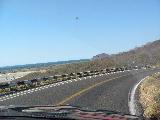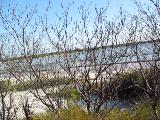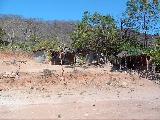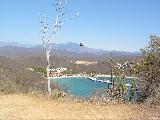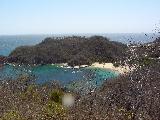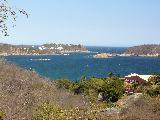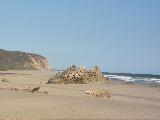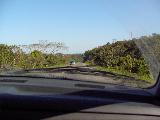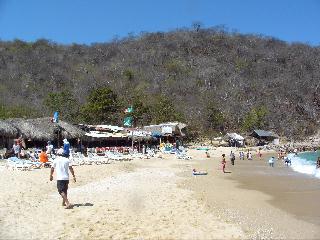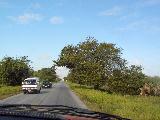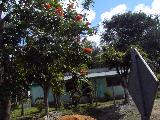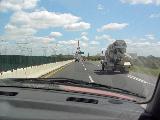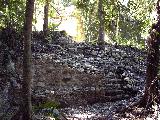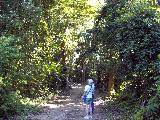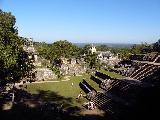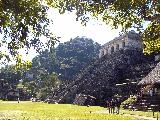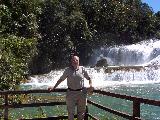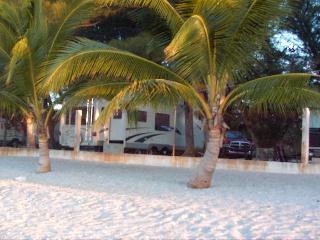If you haven't yet read Part I in Chapter 69 and Part II in Chapter 71, we suggest you do so. This part is kind of a continuation of what was said there. To do that, simply click on the graphic (or its caption) on the right.
A few months ago, I got an email from Paul and Juanita Alton, relating their very interesting experiences RVing from their home in Canada to a mission in Mexico. After reading Paul's vivid and detailed monologue of their maiden RV voyage, I emailed him back and told him that I'd be really excited to be able to send this along to those who read my Travel Log. Here's the story ----
Chapter 69 included a section "Canada to Mexico" on their trip down, and a second section "Into Mexico" that takes you to Oaxaca, Mexico. Chapter 71 tells of some of their "adventures" while in Mexico. The chapter below, and others that follow, document their wanderings on the way out and back to the USA.
One afternoon in January, Juanita and I did a bit of test drive out past the improved highway going slightly beyond Mitla, through the “mescal town” of Matatlán. Teotitlan does rugs, Coyotepec makes black pottery, Atzompa is yellow pottery with holes cut into it (description doesn’t do it justice), and Matatlán’s thing is mescal. Strung along the highway are dozens of small stores with stills out back, distilling, flavoring, bottling and selling their house versions of mescal. Mescal is distilled from fermented maguey cactus. Tequila is a mescal made from a certain variety of maguey cactus found in another part of Mexico. I’m about 32 years safe of having to do mescal comparison taste tests so you will have to find some other authority if you need more on that subject.
During our test drive, as well as concluding that if one stopped at each store and tried one free sample one wouldn’t make to the other end of Matatlán, we decided that the roads were narrow, but doable. The proviso was that we would travel on a Sunday when there was less truck traffic.
One thing that happened on the way down was that we met a caravan of RV’s coming up. Juanita waved to each as we met it. I kept my eyes on the road, because the truck and trailer tend to go where I look. She said that many of the passengers didn’t wave back - they were sitting there looking shell shocked.
BACK TO THE USA
Tehuantepec
After nearly three months at our base near Oaxaca, Oaxaca we left on Sunday, February 12. The road down highway 190 is narrow and a bit windy, but is mostly downhill going from a little over 5,000 feet elevation to about 200 feet at Tehuantepec in about a four hour drive (just under 200 km. downhill through mountain roads).
We had considered going out to the coast with just the truck when Becky and Nick were down for Christmas, but they had had enough driving with the six hour bus drive from Mexico City. Not that it was a bad trip – nice, first-class bus at only moderately high speeds on generally good roads – but six hours there and six hours back was all they wanted of vehicle travel in their ten days in Mexico.
CLICK ANY PHOTO (ALMOST ANY) FOR A LARGER VIEW!
My Travel Log
Nothing in this site is copyrighted -- I'd be honored if you'd reuse anything you find here for your website
Click any photo for a larger view
73. From Canada to Mexico ... and Back - Part III
Canada To Mexico - Chapter 69
In Mexico - Chapter 71
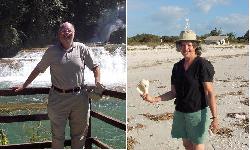
For starters, I thought I'd include a couple of photos of Paul and Juanita. You'll see these again later in this and following chapters, then you'll figure out where they are/were.
I'm doing Chapter 73 and 74 today (7/4/06), then I'll finish up with the final part in a couple of weeks.
According to Church’s guide, there were two places to park our rig near Tehuantepec. One was out in the country and said to be rather lonely. The other was closer to town in the walled area behind a hotel. The hotel Cali won out for us, because we planned to be away for most of Monday and wanted the best security possible. We followed directions through town out to the other side and parked the rig near the hotel entrance and I walked the way in looking for risks and the office. My first stop was through some large glass doors with a large, formal, dining room empty except for me and some naked, reclining Indian women. They were spectacularly life-like, life sized painted sculptures who didn’t have much to say about where to park a trailer so I followed the voices around back and got directions to the officina which was upstairs at the other end of the building. After some discussion I paid the 600 pesos (about $US 60) for two nights complete with electric, sewer and water hook-up. This was the most we paid anywhere on this trip, but it was the only game in town if we wanted to leave the rig for a day. I checked the concrete patio where we were going to park and walked the route back out. Once we wound our way in, only getting a little scraped by overhanging branches and only running over one curb with the trailer tires. Somebody came out from the hotel and directed our parking next to the motor home already parked there. I checked the electrical “service” which was a fifteen amp two-prong outlet. Since that wouldn’t run the air conditioner and it wasn’t that warm we opted to run off batteries and use the roof fan and I added a two prong adaptor to my shopping list for the next time we in a hardware store. The water came out of the tap kinda green for a while, but then it ran clear enough to hook-up our fresh water hose. It’s always a good idea to keep your mouth closed when showering - learned that in the Dominican Republic. Other times are good times to keep your mouth shut, too – that has been a lesson learned with a few hard knocks and I have to admit I am less than a perfect student in applying those lessons. But I digress.
I asked about taxis at the desk and they said if they called a taxi for me the taxi would charge 50 pesos, but if I walked out to the road and flagged one down it would cost about 5 pesos. There must have been a Scotsman hiding in the peat pile somewhere in my Irish Canadian lineage because I didn’t even think there were two options. We walked out to the road and flagged away. Let’s just say we got to town in a Datsun taxi. You can read a little more about it when you read about our time in Villahermosa.
The main thing in Tehuantepec is the central square with putt-putt quad-type vehicles carrying the locals around standing up on a platform in the back. The guide book refers to the “statuesque” female inhabitants. My mental image from that word leans toward tall, busty Viking ladies, not miniature female sumo wrestlers. I guess the guide book and I will have to agree to disagree on the meaning of the word.
We walked around the square once, stopping at stores before checking out the local market, complete with raw meat section (don’t step in the stuff being sloshed onto the grating in that section). We checked a few stores for shoes. The first shoe store had all the samples on display on the wall down one side of the narrow store. There was glass between the would-be customers and the shoes. I think the drill is that you write down the number and size of the shoe on a piece of paper. You hand that paper to one of the clerks at the counter and they go look through the glass at the shoe and tell you they don’t have that size. The sizes are not North American. Maybe the sizes are European. Maybe they don’t want to sell shoes to North Americans. There were locals that seemed to have got shoes to try on, but we had no such luck in that store. We had more luck at the second shoe store where Juanita managed to try on and buy a pair for about 30 pesos. No such luck at the local dress store at finding a mother-the-bride dress.
Having checked the scene for eateries on our way around the square we went back to a rotiserria (sp?, chicken roasting place) but on closer inspection there were no tables. We found a pleasant little restaurant about half a block off the square and had a pleasant little meal at a pleasant little price. We opted to skip dessert at the restaurant and go in search of a paleteria, a paleta store. Paleta, is literally a “stick”, with a Spanish-English dictionary definition of an “ice lolly”. With a definition like that the dictionary must be British, but in any case it doesn’t do paletas justice. You can order ice based or cream based in a vast variety of expected and unexpected flavors. If you order the watermelon (ice based, of course) expect a few seeds. I guess it was siesta time for the paleteria operator, so we walked out to the highway and got on a bus that was sitting there. You don’t pay until you are about to get off and the amount you pay seems to be based on how far you went. If my memory serves me well it was 8 pesos for the two of us. I don’t know what happens if you won’t or can’t pay the requested amount. Do they keep you on the bus until you have to walk just as far back or… ?
When we got back, there was a bus parking around back next to us and another bus disgorging a mountain of luggage out front. We went and sat by the pool and read our books to the background chatter of German tourists until the sun went down and the bugs came out and we went inside to the lobby about the lobby and read some more sitting on the couch and watched out the windows as the wind whipped trees and slammed doors. Tehuantepec is at one side of the isthmus, the narrowest part of Mexico. The winds through here are infamous. There are days you just hunker down and do not venture out to join the semi-trailers lying tipped over at the side of the highway. Monday would have been one of those if we hadn’t already planned a side trip out to the Pacific coast. We were hoping Tuesday wouldn’t be another. Then back to the rig and a bit of supper and off to bed.
Las Bahais de Huatulco
The bays of Huatulco were planned to be the next Cancun – pick a spot, build an airport and some resorts add tourists and poof! - instant economic boom. Some projections put the population at over 600,000 by the middle of the next decade. Things don’t seem to be going quite as planned, but it is a good destination – lots of sheltered beaches, some snazzy resorts, a few marinas and not an overwhelming abundance of touristas.
As we left the hotel grounds we were going to follow the Church’s guide directions to the alternate, rural RV park. The way I read the guide I was to take a right turn out of the hotel gate and was in the process of doing this when I realized there was a string of RV’s coming out of a road and made the guess that I had read wrong and made a sharper right turn than originally intended and followed the directions and almost total lack of signage for a number of kilometers to a short, but steep, downward slope onto a village street. Winding through the village and bearing left at the one junction took us a block further to a dead end in a town square. Glad we left the rig back at the hotel. I cut and filled the truck around until we headed back the way we came and took the junction the other way – the definitely less-traveled looking road and carried on to a spot in a bit of an open forest. Apparently we had arrived. I turned the truck for a quick retreat, if necessary, and got out. The owner showed up from some building about a hundred feet away and we chatted. Definitely cheaper that the hotel. Not much to do around there, but definitely a quiet spot. Good place to go with a caravan, but not sure I would want to be (almost) all alone at night there. Probably not dangerous, but this coward dies a thousand deaths and the coward next to me does it even more vocally.
We retraced our path back past the hotel and along the highway through town and back up the valley toward Oaxaca a ways to where a toll way crossed the highway we came on the day before. We swept along at 110 km/hr. (about 65 mph) on what seemed like our own personal four lane divided highway. We got out near the coast, paid our toll and headed north on the less grand coastal highway 200. It was a bit winding and well paved - just wide enough without excess pavement being wasted on the shoulders. I can see pulling a rig over this, but not too quickly. The highway is on higher ground back of beaches and bays a bit and is punched through the rocky outcrops that poke out to the shore.
In one spot we passed a wide, shallow bay divided up into shallow basins to catch sea water and contain it until all the water has evaporated, leaving the salt. This has been the local industry since before the Spanish showed up.
The towns are pretty poor and most were pretty small, only one or two tope towns. As has been said elsewhere, and will be again, topes are speed bumps set up across the highway as none too gentle reminders to slow down. They are simple, but effective forms of traffic control. In addition to slowing for topes, in one town we had to stop while a herd of pigs crossed the road.
As we wound through the curves on one of the more extensive headlands we suddenly came upon two huge tow trucks pulling something from out of a ravine. They had already pulled the tractor unit of a semi-trailer out and left it on the edge of the next ravine. It looked suitably crumpled without leaving much hope that the driver had been unharmed. We met then again on our way back from Huatulco. They had covered about half the distance toward Huatulco with one truck pulling one the crumpled tractor and the other pulling an almost equally crumpled tanker trailer. From the smell for the next several miles after we passed them it was obvious that the tanker had been full of gasoline. Can’t imagine why there was no fire, but the thing was just crumbled and covered with dirt and vines, not melted and blackened beyond recognition.
We had left the good map book back at the trailer, so there was some confusion about where to turn off the highway towards the coast, but we got a bit more tour of the coast highway and a good way toward the airport north of Huatulco than we would have if we had known better, but it didn’t take too long for us to figure it out and turn around.
We drove back to the turn-off and drove past the town of La Crucecita and then followed a road past a marina through the town of Santa Cruz and out of town towards two of the bays and stopped at a viewpoint on a headland to take pictures looking back toward one beach and down on the next bay.
We headed down into the bay, beat off the people selling boat tours and parked and locked the truck and went for a walk on the beach. We walked from one end to the other, picked up some shells and came back. The tout for one of the restaurants caught us coming and going, but careful queries as to some of the costs made that choice a non option on our budget. I don’t blame them, though. Where they are they probably need to charge what they do to keep the doors, if they had any, open.
When we were close to the near end of the beach we walked on a seawall, admired the boats and rinsed the sand off our feet before buying some peanuts and some fried plantains from a vendor. The price dropped slightly when I said no the first time. Then we drove toward the next bay and took a road looping back into Santa Cruz and headed to the town square in La Crucecita. After once around the square we decided that the restauranteurs had been reading the same guide book we had and adjusted their prices accordingly. We ended up at a less busy, more budget priced café next to where we had started the loop. I think we had some typically Mexican fair like cheeseburger and fries with a soda pop. Tasty, and while we waited for the waitress to come with our food the owner struck up a conversation. After asking about the truck (a.k.a. “Clifford the Big Red truck) he asked where we were from and then he asked how close we lived to his friends in Saskatchewan while he dragged a slip of paper out of his wallet with their mailing and e-mail addresses. The one ton Dodge dually is often a conversation starter since they are made in Mexico, but not sold there. We’ve had a lot of smiles and thumbs up gestures at traffic lights, etc. I’m pretty sure they’re friendly even though the gesture meant something else when I was growing up.
After lunch we found a paleteria and walked a few blocks to a shopping mall of sorts. Inside we walked around once, bought a few knick knacks for the grandkids and checked on our e-mails. Received one from some friends who had left us to go over to their winter digs near Playa del Carmen. The other couple we knew who had gone there had sustained some damage on their trailer undercarriage in road work near Escarcega and then finished the job off breaking a spring on a tope that was lurking in the shade. I still maintain that we had pretty much already made our minds up not to go that far this winter, even before the e-mail. It was a choice between a mad rush to PdC and then a mad rush to the border to get to the Sowers project on time versus a more relaxed, shorter drive with some time to stop for more than a day or two in the same spot(s). Relaxed won. The horror of the road was an ally of that decision.
Got some fuel at a Pemex, and wound our way along the beach road doing a u-turn at one point to come back to a side road with a cardboard sign saying “RV park”. There weren’t any rigs as big as ours, but it looked like we’d fit through the road in and in the sort of a parking lot arrangement stretched along the side of a golf course fairway. There was a chain link fence on the course side and lush, tropical bushes on the other. At the opposite end of the entrance there were a couple of buildings and a path to the beach. Chatted in bad Spanish and worse French with a Quebec couple about the park and its cost. The cost seemed reasonable. They had been there a while and were happy with it. Somebody came by looking for an air compressor, but none of us could help him.
Then we continued our way on the beach road past more resorts including the ubiquitous Club Med which, like the others, had its armed guards on the gate. We didn’t test our theory that day, but both in Mexico and elsewhere I’ve found by being obviously North American and reasonably clean the armed guards never seem to think that it us they are trying to keep out. I often wonder what the locals think about that.
Backlash against historical abuse might be why you tend to get served last in a lot of Oaxacan department stores. It doesn’t always happen. There was one time in Tlacolula where some old ladies in their traditional dress pushed past Juanita at the checkout in the local Pitico supermarket. They were some choked when the clerk shook her finger at them and processed Juanita’s order first.
It must be human nature to discriminate when the opportunity presents itself and the old ladies thought it they heard opportunity knocking only to see the door being controlled by somebody with some manners or a fine sense of the amount of money the orphanage spent there. I don’t think that racism is appropriate no matter which way it is pointed. Whites, males and Christians seem to be fair game in this country these days, but if you fill the blank with the name of a different group and it doesn’t pass the smell test it ain’t right so don’t do it. Sermon/rant over. Three lefts may, but two wrongs don’t make a right as they used to say. Well, almost over. I have a favorite story from a friend who used to work in the NWT for Indian Affairs or whatever they call themselves now. The tale is about a meeting where a local aboriginal type person (I can’t keep up with the PC name of anybody these days) ranted at an obviously Japanese heritage government worker about the centuries of wrongs inflicted by his ancestors on the aboriginal people. I don’t think he was talking about Pearl Harbor either. Sermon/rant definitely over. Maybe even beyond its best before date.
We drove down into a little village on the last bay. Looked like the best spot so far. Almost no people and a class C motor home boondocking on the main street. The beach was not crowded with vendors and had some dramatic rock formations.
Then it was back to the highway. After a few stops at topes to not buy cut-up fruit from vendors (one kid didn’t take it well, and hit the truck, needs a marketing course among other things) we carried on the about a two and fifty hundred klick (Canadian for kilometer) drive to and through Salina Cruz and back to Tehuantepec. I can see why they built the bypass highway. The old road is almost okay in a pickup. Would have been a nightmare pulling anything. Curvy, hilly, narrow roads with traffic congestion and ambiguous signage. Got home okay to find one of the buses replaced with a big fifth wheel trailer from Washington and another bus - this one with English tourists.
We got back just before dark. You do not want to drive at night in Mexico. The reasons are legion: animals sleeping or walking on road; drunks walking, cycling, driving or sleeping on road; road missing; guilty-until-proven-innocent laws; and on and on. Just don’t.
A brief repeat performance of our lounge by the pool and in the upper lobby and then supper and back to bed. I love a routine. Nothing like a five hundred kilometer drive and a walk on the beach to work the kinks out.
Crossing the Isthmus
Tuesday, we were up early. The winds were almost non-existent and the earlier the better when crossing the istmo (isthmus, but I bet you guessed that without my help). Unhooked things, threw out the trash, and backed up the truck to the trailer. Chatted with the owner of the big rig from Washington state. Seems they came down the Pacific coast of Mexico all the way.
The first half or so of the distance down is toll roads. Once the toll roads ran out he said it was still pretty good, with the roads about the same south of Acapulco as we had seen on our way to and from Huatulco, yesterday. He did mention the issue of the shrubbery being trimmed by the semis (and the odd fifth wheel) rather than work crews so one could expect a bit of risk to scratching the sides from the bushes.
We headed out, ignoring the gardener waving about going the wrong way up the boulevard to turn onto the boulevard to the gate. He eventually stopped when it looked like I would make the turn okay and did, this time without running over any curbs, which wouldn’t have been the case if I followed the rules. Down the highway with our next “destination” being Juchitan. It is always good to know the next city or town since highway numbers and highway number signage are of mixed quality and quantity, but the signs telling the of choices at junctions are usually pretty good. This can be a trap if you get too fixated on it. I ignored Juanita’s “turn here” command when we were at an intersection. I had moved on to thinking about the next town, La Ventosa, so was able to resist the lure to turn onto a road that would have lead us to downtown Juchitan and the inevitable zocolo or town square. But one should not get too proud of navigational sense and triumphs. Pride goeth before a fall, or in our case, a rise. As the highway turned at La Ventosa and we left the built-up area I increased speed and had quite a head of steam built up when it became obvious that the build-up area was not done with us. I think that we both yelled “tope!” at the same time, but the truck didn’t listen and even with me standing on the brakes we took quite a jolt. Actually four jolts. One for each axle.
Finally the lowlands came to an end and we approached a road up a mountainside. Not too much of one. Only being something like five hundred feet at its highest, but a bit of a climb over reasonably good road. As the road angled up we passed a bus stop on its own which was the only thing on the road relating to the cluster of roofs which we took to be La Mata. There was also a semi-permanent warning of a spot where most of the downhill lane had disappeared into a hole and the traffic became one lane both ways around it. It was pretty well marked with painted pavement, signs and all, but still another reason you don’t want to drive in the dark.
Just before we ran out of lowlands there was a junction with what looked like the other end of the toll road we had taken to the coast the day before. It didn’t show up on the map at all, but once it does or some other exploration or advice from other travelers confirms it is there, it will definitely be the way to get around the towns and the topes.
Well, back to the mountain. In a relatively short, relatively uneventful trip over the ridge and a few more ups and downs we found ourselves on some good road and some bad road, but no really terrible road on the lowlands leading to the Caribbean coast. We parted with some pesos to a woman who was standing on a tope selling something that was a cross between a cake and a muffin. It was a bit on the sweet side and seemed to be corn meal based. Very filling and probably a good source of fiber. One wouldn’t eat several of these at one sitting, but they are definitely reasonable substitutes for the morning pan dulce (sweetbread) that is common in much of Mexico.
There was a military and drug checkpoint, complete with drug dog. Everybody was wearing their photo i.d. hanging from their waists or necks. I had heard from somebody who spent a lot of time traveling in Mexico that he tended to get searched a lot more once his Spanish improved and he used it at checkpoints. Since reverting to “no hablo” and blank looks when they addressed him in Spanish the searches diminished. I have followed suit and found that we still got the odd look inside our casa from the bored and the curious but no real hassles. Smile, co-operate, but don’t understand or speak Spanish seems to be the best approach.
Our habit, in Mexico, was to stop for re-fueling at the half-full mark on the fuel gauge. I had been wondering if this was still the best approach but it was confirmed as a good practice at our next fuel stop. They had no diesel and “maybe” the next gas station would. It did. I doubt this was the cause, but I have heard of one of the downsides of caravans of RVs is that they all stop for fuel at once and can empty the tanks of a gas station even to the point that the tail-enders don’t get any. That’s just another addition to my long list of reasons why I wouldn’t want to travel in a caravan. Some people like them. Other people hate them but lack the confidence to travel solo. And then there are those who shudder at the very thought and will take to the roads alone.
We carried on north, with Acayucan as the target city. Actually the target is the autopista that the highway to Acayucan crosses just before Acayucan. We succeed at the transition and are back at 110 km/hr headed east deeper into Mexico (east doesn’t seem right, does it?). Crossed a few rivers and stopped at a meticulously clean Pemex station and sat in the truck and ate a couple of ham and cheese sandwiches on white.
The trip through Villahermosa was straightforward thanks to the map that somebody had marked up for us and soon we were over another river and in a construction zone with single lane traffic. Eventually the road widened and all the traffic on our side stayed in a single lane with three lanes coming toward us. All the traffic in the oncoming lanes was in the lane next to ours, and two empty lanes next to them. I guess they had been directed that way by control cones some distance back and just stayed that way. There were few breaks in the oncoming traffic and none of them were particularly long lasting. The vehicles in front of us took advantage of the breaks until there was nothing but us following the leading vehicle, a slow poke dump truck. None of the oncoming gaps was wide enough to consider passing with our limited acceleration capability. Time for thinking outside the box. I passed anyway. Eventually the oncoming traffic moved over a lane. I hadn’t heard honking for a while anyway.
Palenque
Not too long after that successful effort to re-align the thinking and lane of the oncoming traffic we got to the turn off to Palenque. After we turned we had to endure the same number of speed bumps that the traffic approaching the intersection did. Let’s face it, there is no point putting the topes on just one side of the highway, people will just go around them and then collide with people turning the corner. This was a more typical two lane country highway, but the pavement was in good shape and there wasn’t much traffic.
After passing through the edge of Palenque we turned on the road up to the Mayan ruins and turned off for the campground behind Las Leones (the lions) restaurant. I was a little confused about exactly where to turn, but backing up and taking another run at it allowed us to get un-high-centered and up the slope and off the wrong driveway onto the right driveway. Parked and unhooked the truck and hooked up the trailer with no incidents of note and visited with a couple from Alberta who had come down the Pacific coast and a guy from BC. The couple from Alberta had got all dressed up for her birthday and were going to the restaurant, but we took a pass, partly to not crash their party and partly to stay on budget.
There were signs of it having rained, but it didn’t that night or the next morning. We got up early and headed up to the ruins. The restored ruins are extensive, good for several hours of touring. The unrestored ruins are even more extensive and said to go some distance back into the jungle. I have heard from friends that it is possible, if not totally legal, to hire a guide for the ruins one day and then make arrangements for a “private” tour of the unreclaimed ruins in the jungle. I’ll take their word for it. I enjoyed the official tour, but the juices of my spirit of adventure don’t get flowing at the thought of walking through the jungle looking at piles of moss covered rocks.
We were up to the ruins early in the tour on Wednesday and had no problem getting a parking spot. After some haggling I got the local kids to agree to wash the truck for 50 pesos and then worked it back up to 100 pesos if they used the bug and tar remover to take off all the little gobs of tar and pine sap that had been there since Meadow Lake Provincial Park the previous summer. They also took off a few bugs.
Normally we just walk around ruins and read the signs, but we wanted to learn a bit more about these ones. So we started negotiating with guides. The English speaking guides wanted 600 pesos to guide us - the Spanish speaking ones 300 pesos. Probably could have got him down further, based on his later comments, but I was coming from the 600 prespective and more than happy to settle there. I figured he could talk and I could translate for Juanita. It worked out better than that. To our surprise, Juanita had learned much more than she thought she had working in the kitchen for three months mostly with Spanish-only speakers. I hardly had to translate at all.
The tour included a walk through the jungle to look at the local flora and a few howler monkeys. One of the pleasures of camping at Palenque if your rig will fit in one of the smaller campgrounds closer to the ruin (e.g. the Mayabelle, magnet for VW camper vans and other vehicles that would fit in in Lund, BC) is listening to the howler monkeys at night. We had to be content to look up into the trees near the ruins at a few sleeping howler monkeys.
The ruins are impressive. I hear they are just part of an extensive Mayan civilization that seemed to have collapsed on itself when the overburden from the unproductive entities in charge became too great for the masses to carry (are you listening Ottawa?). At least that’s one theory. They say that it doesn’t seem to have been outside forces like in the case of the Spanish and the Aztecs. Or the Aztecs and some other groups. Or like us and whoever is next.
After the guided tour was over we walked back to the ruins furthest from the gates and did some climbing and picture taking and bought a souvenir for our son-in-law, Ernie. Then we went out to the truck, encouraged the kids to keep rubbing off tar gobs, had a couple of pops and shopped and haggled for a couple of Chiapan souvenirs at the cluster of stands near the parking lot. Then it was down the hill, past the museum and a quick drive through the Mayabelle and out onto the road again.
Aqua Azul
We had planned on staying three nights a Las Leones before moving on; doing the ruins on Wednesday and the waterfalls on Thursday, but we had seen everything we wanted at the ruins and it wasn’t quite noon yet. There was more to see in a museum, but it didn’t appeal to either of us so we headed back to the park, grabbed some water bottles, chatted with the guys working the fields over the fence about whose vanilla vines it was they were tending and where we could buy vanilla and then headed into the hills, deeper into Chiapas.
We took a decent road up. We met a few smaller rigs on it, but not sure I’d choose to take a big rig on this highway over the hills to the other side of Mexico. I know some who have done it and who claim it is spectacular, but then again their rig is almost ten feet shorter in length with a bit less height. There is no “perfect rig” for Mexico. Some days I think I would like a small camper van to explore more and other days I really appreciate the comfort of our home, especially when we are in the same place for three months.
We passed through a few small towns, including one where there was an assassination of a minor political figure a few weeks later. These Chiapan hills are the Ozarks of Mexico. I’ve driven through the Ozarks, too, and they, too, seem quite okay viewed through a vehicle window, but they can be or were insular and used to taking care of their own problems their own way. Chiapas is a little further back on the scale of political progress.
After a while we headed back to Palenque, not slowing down for ropes across the road. They drop them pretty quickly when they realize you aren’t going to stop. At Palenque we parked near the square and walked around, hit a couple of Internet cafes (the first had somebody gaming at full volume and loud rock music - we tolerated it for a little while then paid and left) and I went and got a couple of paletas and brought one back to Juanita at the second Internet café. Then we drove to near the bus station, checked out the organic coffee some guide book had mentioned at a store next door and took a pass since they only had pre-ground, not beans. After a bit of a stock up on mango juice at another store we headed back to where home was parked and puttered around with dinner and so on.
At a few places there were groups of women, all of them smiling and some of them quite pretty who had strung ropes across the road so you had to stop while they tried to sell you stuff. They would climb onto the running boards and wave their wares at you. We bought a small bunch of tiny bananas at one rope stop and a bag of fried plantains at another. Since each group was selling basically the same things we ran out of consumer impulse before we ran out of ropes. The interchanges were less pleasant and the smiles disappeared. No real damage was done to the truck. By the time we turned onto the side road down the mountain toward the Cascadias de Aqua Azul, (typically called just Aqua Azul, but meaning the waterfalls of blue water) we had had enough and quickly got right behind a car stopped at a rope and tailgated our way past before they had time to raise it again. There were two more stops near the entrance to the falls. Not sure which was the “official” one. They both handed you an official-looking, printed receipt but at least one of them was a village tax grab.
There was lots of parking and I paid a kid to watch our truck. I don’t think he did much watching, but in our absence he followed the Hippocratic command to “first do no harm”. We walked past some booths selling food and souvenirs and got to a spot at the bottom of where the main falls came down and took a few pictures. We checked out the food stalls, but nothing appealed after stuffing ourselves with various forms of banana, and then settled on the grass next to the river with other sunbathing tourists to read our books. There were a few vendors. One was a little girl who was as much interesting in talking to us as selling anything. I had purposed to buy something from one of the kids when she came by again but she never did. There were less than twenty people sitting and laying around this lovely spot. I highly recommend you go there as long as your going doesn’t make it crowded.
Travel to Isla Aquada
From an e-mail:
"Thursday we got as far into Mexico as we expect to this trip and made the turn out to the coast and started heading up the coast on a chain of islands. Right now we are camped in an RV park at Isla Aquada. Temperature is in the high twenties. The water is about thirty feet from our back bumper and it seems like a vacation."
Paul & Juanita
TO BE CONTINUED ..




